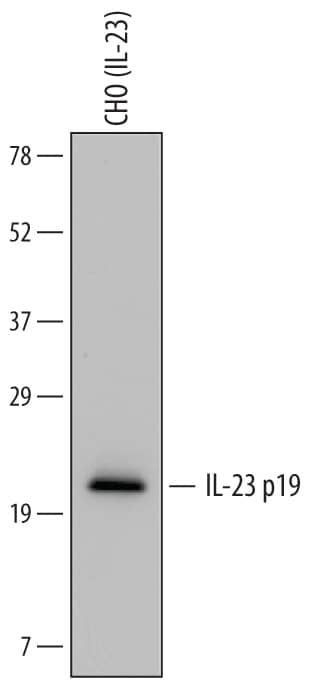Human IL-23 p19 Antibody
R&D Systems, part of Bio-Techne | Catalog # AF1716

Key Product Details
Species Reactivity
Validated:
Cited:
Applications
Validated:
Cited:
Label
Antibody Source
Product Specifications
Immunogen
Arg20-Pro189
Accession # AAG37232
Specificity
Clonality
Host
Isotype
Endotoxin Level
Scientific Data Images for Human IL-23 p19 Antibody
IL-17 Secretion Induced by IL-23 and Neutralization by Human IL-23 Antibody.
In the presence of Recombinant Mouse IL-2 (10 ng/mL, Catalog # 402-ML), Recombinant Human IL-23 (Catalog # 1290-IL) stim-ulates IL-17 secretion in mouse splenocytes in a dose-dependent manner (orange line), as measured by the Mouse IL-17 Quantikine ELISA Kit (Catalog # M1700). Under these conditions, IL-17 secretion elicited by Recombinant Human IL-23 (0.75 ng/mL) is neutralized (green line) by increasing concentrations of Goat Anti-Human IL-23 p19 Antigen Affinity-purified Polyclonal Antibody (Catalog # AF1716). The ND50 is typically 0.2-0.8 µg/mL.Detection of human IL‑23 p19 by Western Blot.
Western blot shows lysates of a CHO cell line transfected with human IL-23. A PVDF membrane was probed with 1 µg/mL of Goat Anti-Human IL-23 p19 Antigen Affinity-purified Polyclonal Antibody (Catalog # AF1716) followed by HRP-conjugated Anti-Goat IgG Secondary Antibody (Catalog # HAF109). A specific band was detected for IL-23 p19 at approximately 21 kDa (as indicated). This experiment was conducted under reducing conditions and using Immunoblot Buffer Group 1.Applications for Human IL-23 p19 Antibody
Western Blot
Sample: CHO Chinese hamster ovary cell line transfected with human IL-23
Neutralization
Formulation, Preparation, and Storage
Purification
Reconstitution
Formulation
Shipping
Stability & Storage
- 12 months from date of receipt, -20 to -70 °C as supplied.
- 1 month, 2 to 8 °C under sterile conditions after reconstitution.
- 6 months, -20 to -70 °C under sterile conditions after reconstitution.
Background: IL-23
Interleukin 23 (IL-23) is a heterodimeric cytokine composed of two disulfide-linked subunits, a p19 subunit that is unique to IL-23, and a p40 subunit that is shared with IL-12. The p19 subunit has homology to the p35 subunit of IL-12, as well as to other single chain cytokines such as IL-6 and IL-11. The p40 subunit is homologous to the extracellular domains of the hematopoietic cytokine receptors. Human p19 cDNA encodes a 189 amino acid residue (aa) precursor protein with a putative 19 aa signal peptide and 170 aa mature protein. Human and mouse p19 share 70% aa sequence identity. Although p19 is expressed by activated macrophages, dendritic cells, T cells, and endothelial cells, only activated macrophages and dendritic cells express p40 concurrently to produce IL-23. The functional IL-23 receptor complex consists of two receptor subunits, the IL-12 receptor beta 1 subunit (IL-12 R beta1) and the IL-23-specific receptor subunit (IL-23 R). IL-23 has biological activities that are similar to, but distinct from IL-12. Both IL-12 and IL-23 induce proliferation and IFN-gamma production by human T cells. While IL-12 acts on both naïve and memory human T cells, the effects of IL-23 is restricted to memory T cells. In mouse, IL-23 but not IL-12, has also been shown to induce memory T cells to secret IL-17, a potent proinflammatory cytokine. IL-12 and IL-23 can induce IL-12 production from mouse splenic DC of both the CD8- and CD8+ subtypes, however only IL-23 can act directly on CD8+ DC to mediate immunogenic presentation of poorly immunogenic tumor/self peptide.
Long Name
Alternate Names
Gene Symbol
UniProt
Additional IL-23 Products
Product Documents for Human IL-23 p19 Antibody
Product Specific Notices for Human IL-23 p19 Antibody
For research use only

